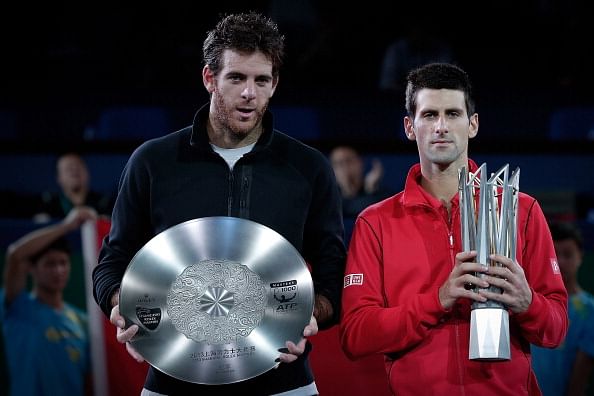
Talking tactics: Why Del Potro couldn't master Djokovic like he did Nadal in Shanghai

Juan Martin Del Potro ran Novak Djokovic close again, but could not get over the finish line
Novak Djokovic made it two title wins in two weeks when he successfully defended his Shanghai Masters crown against an in-form Juan Martin Del Potro.
Del Potro himself has had a fine run on the Asian leg of the tour after winning in Japan and finishing runner-up yesterday at Shanghai. The duo were involved in a superb game of tennis that had many moments of technical brilliance from both players.
Djokovic in the end used his big-match experience to pull through in the tie-breaker and make it a rare back-to-back sequence – he successfully defended his crowns at both the China Open in Beijing last week and Shanghai yesterday – making China a very happy hunting ground for the Serb.
Del Potro had dismantled new world number 1 Rafael Nadal in the semi-final and was coming into the final high on confidence. Yet the Serb came up with a tactically astute game plan to neutralize some of the Argentine’s strengths which in the end enabled him to claim victory.
Here’s a statistical look at yesterday’s match as well as the major differences in Del Potro’s matches against Nadal on Saturday and against Djokovic yesterday that proved crucial in deciding the outcome of the respective games.
Serve and return
Unlike in his semi-final match against Nadal, Del Potro made a rather slow start in the final. And Djokovic took full advantage of this by not allowing him to settle on serve.
Djokovic is an excellent returner of serve, one of the best on tour alongside Andy Murray. Del Potro had a first serve percentage of 56% in the first set. Even in the points where he got his first serve in, the Argentine only managed to win 57% of the points and his big serve did not give him the advantage that he had hoped to get.
Much of it was down to the quality of Djokovic’s returns though Del Potro was also guilty of being a bit predictable. He sent in a majority of his serves down the line, both on the ad court as well as the deuce court, which provided easy pickings for Djokovic who had managed to get a good read on them.
Unlike Nadal who stands a little deeper in the court while receiving, Djokovic was stepping into the court and taking the ball early in a bid to pressurize Del Potro in the rallies. And the ploy worked, as it didn’t allow the Argentine to get into his hitting rhythm.
He got butchered on his second delivery as well as he won just 27% of the points when he was asked to deliver a second serve, with the world number 2 pouncing all over it.
In fact, in the whole of the opening set, Djokovic failed to get Del Potro’s serve back in the court on only two occasions out of the 25 points which his opponent served. So there were no easy points on serve for Del Potro.
He faced five break points in the set and though he managed to save three of them, the relentless pressure in almost every service game of his ensured that he was broken twice.
Djokovic, in comparison, served supremely well, getting in 78% of his first serves with plenty of variety to boot, preventing Del Potro from getting his big swings in and asserting his authority on the points. He served so well that he lost just six points on serve the whole set.